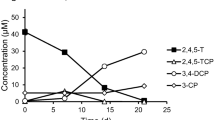Abstract
Studies were conducted to elucidate the mechanism of action of 2-chloro-6-(trichloromethyl)pyridine or Technical N-SERVE on the nitrification process brought about byNitrosomonas europaea. The growth ofNitrosomonas was completely inhibited in the presence of 0.2 ppm N-SERVE while 1.0 ppm of the chemical was effective in the complete inhibition of ammonia oxidation by fresh cell suspensions. Cells stored at 4 C for a period of three days required somewhat higher concentrations (1.5 ppm) of N-SERVE for the complete inhibition of their ammonia oxidizing ability while the cytochrome oxidase of these cells was inhibited to the extent of 65 to 70 percent in the presence of a corresponding amount of N-SERVE. A 45 – 70 percent reversal of the inhibition of ammonia oxidation caused by N-SERVE was obtained by the addition of 6×10−4 M Cu++. An equivalent concentration of Cu++ was also effective for the complete reversal of the inhibition of cytochrome oxidase present in whole cells.
Hydroxylamine oxidation by intactNitrosomonas cells was not affected by levels of N-SERVE ranging from 1 – 3 ppm. The cytochrome oxidase effective in hydroxylamine oxidation and present in cell-free extracts was not inhibited by even 100 ppm N-SERVE. Likewise, the hydroxylamine activating enzyme “hydroxylamine cytochromec reductase” was also not inhibited by such levels of the chemical. Raising the concentration to 170 ppm N-SERVE, however, caused a 90 percent inhibition of the enzyme.
Although a 5×10−6 M concentration of allylthiourea completely inhibited ammonia oxidation byNitrosomonas cells, concentrations up to 10−3 M of this compound did not affect the cytochrome oxidase activity of whole cells or cell-free extracts. The inhibition of ammonia oxidation caused by 5×10−6 M allythiourea, unlike the inhibition by N-SERVE, could not be reversed by the addition of 6×10−4 M Cu++.
Evidence is presented that the action of N-SERVE is on that component of cytochrome oxidase which is involved in ammonia oxidation.
Similar content being viewed by others
References
Aleem, M. I. H. andLees, H. 1963. Autotrophic enzyme systems. I. Electron transport systems concerned with hydroxylamine oxidation inNitrosomonas. Can. J. Biochem. Physiol.41: 763–778.
Cutler, D. W. andMukerji, B. K. 1931. Nitrite formation by soil bacteria other thanNitrosomonas. Proc. Roy. Soc. (London) Ser. B108: 384–394.
Eylar, O. R. andSchmidt, E. L. 1959. A survey of heterotrophic micro-organisms from soil for ability to form nitrite and nitrate. J. Gen. Microbiol.20: 473–481.
Fisher, T., Fisher, E. andAppleman, M. D. 1956. Nitrite production by heterotrophic bacteria. J. Gen. Microbiol.14: 238–247.
Goring, C. A. I. 1962a. Control of nitrification by 2-chloro-6-(trichloromethyl)pyridine. Soil Sci.93: 211–218.
Goring, C. A. I. 1962b. Control of nitrification of ammonium fertilizers and urea by 2-chloro-6-(trichloromethyl)pyridine. Soil Sci.93: 431–439.
Hirsch, P., Overrein, N. andAlexander, M. 1961. Formation of nitrite and nitrate by actinomycetes and fungi. J. Bacteriol.82: 442–448.
Hofman, T. andLees, H. 1953. The biochemistry of the nitrifying organisms. 4. The respiration and intermediary metabolism ofNitrosomonas. Biochem. J.54: 579–583.
Lees, H. 1954. The biochemistry of the nitrifying bacteria. p. 84–98.In Autotrophic micro-organisms. 4th Symp. Soc. Gen. Microbiol. University Press, Cambridge.
Lees, H. 1955. Biochemistry of autotrophic bacteria. Butterworths Scientific Publs., London.
Nicholas, D. J. D. andJones, O. T. G. 1960. Oxidation of hydroxylamine in cell-free extracts ofNitrosomonas europaea. Nature185: 512–514.
Snell, F. D. andSnell, C. T. 1949. Colorimetric methods of analysis, 3rd ed., vol. 3. D. Van Nostrand Co., New York.
Turner, G. O., Warren, L. E. andAndriessen, F. G. 1962. Effect of 2-chloro-6-(trichloromethyl)pyridine on the nitrification of ammonium fertilizers in field soils. Soil Sci.94: 270–273.
Author information
Authors and Affiliations
Rights and permissions
About this article
Cite this article
Campbell, N.E.R., Aleem, M.I.H. The effect of 2-chloro, 6-(trichloromethyl) pyridine on the chemoautotrophic metabolism of nitrifying bacteria. Antonie van Leeuwenhoek 31, 124–136 (1965). https://doi.org/10.1007/BF02045882
Received:
Issue Date:
DOI: https://doi.org/10.1007/BF02045882




